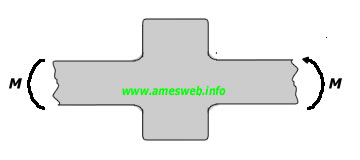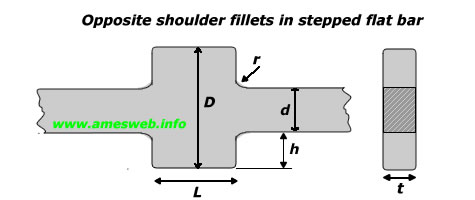Opposite shoulder fillets in stepped flat bar. Stress concentration factors (Kt) calculator for tension, bending and torsion loads.
Note: Use dot "." as decimal separator.
|
RESULTS |
|
LOADING TYPE - TENSION |

|
|
Parameter |
Value |
|
Stress concentration factor [Kt]
* |
---
|
--- |
|
Nominal tension stress at flat bar [σnom ] o |
---
|
|
|
Maximum tension stress due to tension load [σmax ] |
---
|
|
LOADING TYPE - BENDING |

|
|
Parameter |
Value |
|
Stress concentration factor [Kt]
* |
---
|
--- |
|
Nominal tension stress at flat bar [σnom ] + |
---
|
|
|
Maximum tension stress due to bending [σmax ] |
---
|

|
|
Tension |

|
|
$$0.1\le \frac { h }{ r } \le 2.0$$ |
$$2\le \frac { h }{ r } \le 20$$ |
|
$${ C }_{ 1 }=1.006+1.008\sqrt { h/r } -0.044h/r$$ |
$${ C }_{ 1 }=1.020+1.009\sqrt { h/r } -0.048h/r$$ |
|
$${ C }_{ 2 }=-0.115-0.584\sqrt { h/r } +0.315h/r$$ |
$${ C }_{ 2 }=-0.065-0.165\sqrt { h/r } -0.007h/r$$ |
|
$${ C }_{ 3 }=0.245-1.006\sqrt { h/r } -0.257h/r$$ |
$${ C }_{ 3 }=-3.459+1.266\sqrt { h/r } -0.016h/r$$ |
|
$${ C }_{ 4 }=-0.135+0.582\sqrt { h/r } -0.017h/r$$ |
$${ C }_{ 4 }=3.505-2.109\sqrt { h/r } +0.069h/r$$ |
$${ K }_{ t }={ C }_{ 1 }+{ C }_{ 2 }\frac { 2h }{ D } +{ C }_{ 3 }{ (\frac { 2h
}{ D } ) }^{ 2 }+{ C }_{ 4 }{ (\frac { 2h }{ D } ) }^{ 3 }$$
where
$$\frac { L }{ D } >-1.89(\frac { r }{ d } -0.15)+5.5$$ |
|
$${ \sigma }_{ nom }=P/td$$ |
|
$${ \sigma }_{ max }={ K }_{ t }{ \sigma }_{ nom }$$ |
|
Bending |
 |
|
$$0.1\le \frac { h }{ r } \le 2.0$$ |
$$2\le \frac { h }{ r } \le 20$$ |
|
$${ C }_{ 1 }=1.006+0.967\sqrt { h/r } +0.013h/r$$ |
$${ C }_{ 1 }=1.058+1.002\sqrt { h/r } -0.038h/r$$ |
|
$${ C }_{ 2 }=-0.270-2.372\sqrt { h/r } +0.708h/r$$ |
$${ C }_{ 2 }=-3.652+1.639\sqrt { h/r } -0.436h/r$$ |
|
$${ C }_{ 3 }=0.662+1.157\sqrt { h/r } -0.908h/r$$ |
$${ C }_{ 3 }=6.170-5.687\sqrt { h/r } +1.175h/r$$ |
|
$${ C }_{ 4 }=-0.405+0.249\sqrt { h/r } -0.200h/r$$ |
$${ C }_{ 4 }=-2.558+3.046\sqrt { h/r } -0.701h/r$$ |
$${ K }_{ t }={ C }_{ 1 }+{ C }_{ 2 }\frac { 2h }{ D } +{ C }_{ 3 }{ (\frac { 2h
}{ D } ) }^{ 2 }+{ C }_{ 4 }{ (\frac { 2h }{ D } ) }^{ 3 }$$
where
$$\frac { L }{ D } >-2.05(\frac { r }{ d } -0.025)+2$$ |
|
$${ \sigma }_{ nom }={ 6M }/{ t{ d }^{ 2 } }$$ |
|
$${ \sigma }_{ max }={ K }_{ t }{ \sigma }_{ nom }$$ |